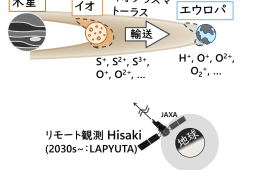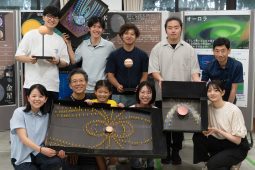PPARCセミナー (2025/06/23)

PPARCセミナー (2025/06/23)
(1)
[Name]
Chizuru Nose
[Title]
Influence of the solar wind on the hydrogen airglow in the Venusian upper atmosphere observed by Hisaki and VEX
[Abstract]
One of the big questions for Venus is whether or not Venus had an Ocean in the past. While Venusian current atmosphere is extremely dry, isotopic measurements of the D/H ratio suggest that Venus likely retained significant amounts of water in its past. Observations of hydrogen and oxygen in Venusian upper atmosphere can provide constraints on these processes. Results from Venus Express have shown the presence of hot and cold components in the Venusian hydrogen corona at different scale heights. It was suggested that charge exchange between the cold component and ionospheric or solar wind protons play a significant role in producing the hot component (Chaufray et al. 2012).Observations from Hisaki have shown that, when the high-speed solar wind originating from a corotating interaction region (CIR), arrived, the hydrogen column density derived from Ly-α increased by approximately 10% over a few days and then remained almost constant for weeks. The column density derived from Ly-β almost constant during this period. One possible explanation for the ~10% variations in Ly-α and the relatively stable Ly-β is an increased high-altitude hot hydrogen abundance due to interaction between the Venusian upper atmosphere and the high speed solar wind. However, since the Hisaki observations measured the globally averaged hydrogen column density, they could not resolve altitude-dependent variations.
In this seminar, we discuss the mechanisms behind the observed increase in hydrogen column density. Using a radiative transfer model, we calculate the Ly-α brightness and estimate the extent to which the hot hydrogen component increases under varying solar wind conditions.
(2)
[Name]Hiroaki Misawa
[Title]Long term variations of Jupiter’s auroral radio emission – III
[Abstract]In order to investigate control factor(s) of Jupiter’s long-term magnetospheric variations, we have investigated occurrence features of Jupiter’s auroral radio emission (JAR) using the radio wave data observed with the Radio and Plasma Wave Investigation (WAVES) onboard the WIND satellite. This radio wave data has an excellent advantage of providing continuous 24-hour data with stable, high sensitivity over a long period of more than 25 years. We have derived JAR occurrence rates from the WAVES data observed in the frequency range of 1 to about 14MHz around every Jupiter’s opposition to the Earth for 1995-2020. The results are interesting; i.e., the occurrence rates show almost monotonous decrease from 1995 to 2005, then gradual increase from 2005 to 2012, but change to somewhat complex nature with increase and decrease, and around 2020 they showed relatively high occurrence rate for both non Io-related and Io-related JAR components. It does not seem to correspond to simple variations of De (Jovicentric declination of the Earth) and solar and/or solar wind activities those have been discussed as plausible causalities ever, but implies that some other or multiple causalities control the long term variations. In this seminar, we will discuss one of the possible candidates for the cause of the long term variation, the relationship between the variations of Iogenic gas/plasma and JAR.





